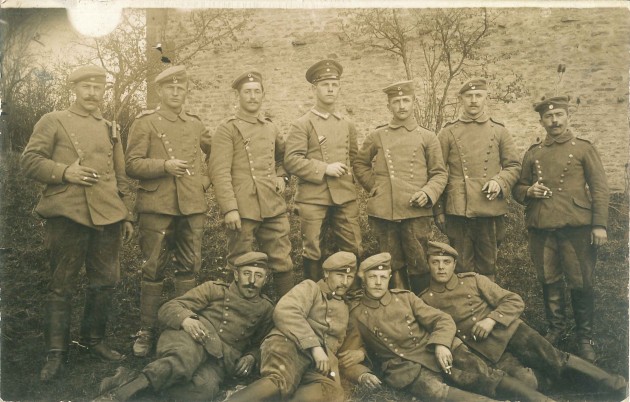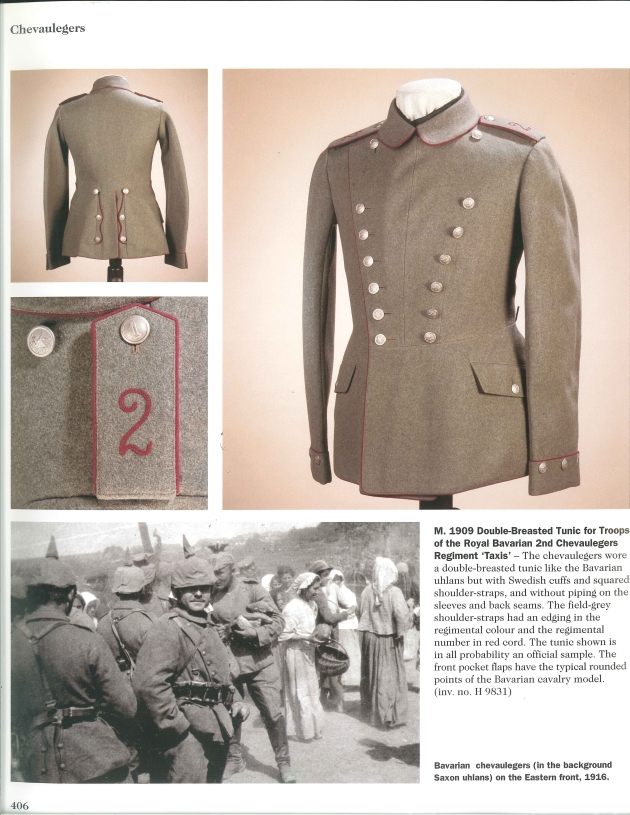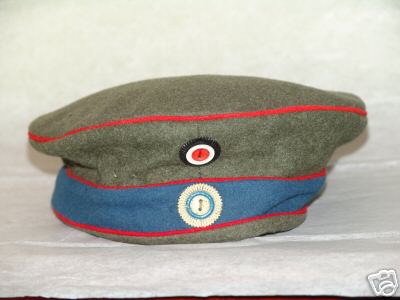
1 Eskadron, 2 Chevauleger; Here one can see a sergeant standing in the center rear, wearing a private purchase visor cap. The others are all enlisted men.
Below is a brief introduction to uniforming in the 2 Chevauleger. As with everything in the living history world, this is a work in progress and constantly evolving as more information is discovered.
As a living history organization, we have several “looks” or impressions that we use to portray the 3 Eskadron (squadron) of the 2 Chevauleger Regiment. Our primary impression is that of the regiment during the 1917-18 time frame which conforms with the Great War Historical Society’s primary emphasis. Uniforms and equipment changed throughout the war for all the combatants and the Germany Army was no exception. Below are two illustrations made by Randall Chapman for us of the basic uniform and most of the equipment:
Above is the basic duty uniform. The boots are the 1915 pattern Universal Bavarian Cavalry Boot. There were originally made in brown and then later blacked per official directive by the Bavarian War Ministry in March 1916. Also, as the war progressed, ankle boots were increasingly issued, to be worn with puttees, as a leather-saving measure. It is perfectly acceptable for either to be worn.
The above picture is interesting for several reasons. First, the Chevauleger is wearing ankle boots and puttees. Also, he is wearing his bayonet or “side-arm” per regulation. Swords were phased out of front-line use by order in 1915 so you begin to see the sword knot or Faustriemen used with the bayonet.
This one is similar to the one before except that the Chevauleger is wearing the 1915 Bavarian Universal Pattern Riding Boots.
Now let’s take a look at some original pieces of uniform. The first is the 1909 tunic or Ulanka:
The above pictures illustrate the back and front of the 1909 Tunic. The 2 Chevauleger’s facing color was carmine red and this was reflected in the trim running along the collar, tunic hem, cuffs, and rear. Also, the buttons are nickle/silver which is also unique to the 2 Chevauleger.

 The above two images are taken from Jurgen Kraus. The line drawing is especially helpful. The tunic had shoulder boards with the number of the regiment and the piping running along the outside was in carmine. The color of the thread creating the number was supposed to be red (as opposed to the carmine in the outer piping).
The above two images are taken from Jurgen Kraus. The line drawing is especially helpful. The tunic had shoulder boards with the number of the regiment and the piping running along the outside was in carmine. The color of the thread creating the number was supposed to be red (as opposed to the carmine in the outer piping).
Next, we take a lot at the basic undress cap known as the Mütze or Feldmütze:
The Mütze followed the basic pattern pictured above although the color band was the regimental facing color, carmine. The top cockade was the national cockade for the German Empire and the lower one was distinct for Bavaria. Below is a reproduction Mütze specially made for the unit (since I was unable to locate an image of an original):
Above is the uniform and basic weapons and equipment. The primary weapon was the Kar 98AZ which was a carbine that was a lot more easy for a cavalry soldat to carry. Also, the ammunition pouches carried half the ammunition that the infantry version carried and the basic design was adopted for army-wide use in the Second World War. Leather Y-straps were also issued, something that the infantry lacked (they used the strap from their bread bag). The equipment and weapons will be discussed further in detail on their respective pages.
The pictures above illustrate elements of the Chevauleger uniform that were in use at the start of the war in 1914. As the war progressed, German Army uniforms changed, becoming more simplified in construction and designed to use less materials. For the 2 Chevauleger, change seemed to have come slowly and we see instances of the men wearing their 1909 tunics well into 1918. We will deal with these later uniforms in later posts.
Below is a gallery of original photographs that are helpful in understanding the various unique aspects of the Chevauleger uniform:
- Chevaulegers in the 1915 Bavarian Universal Cavalry Boots.
- Chevauleger with Tornister for dismounted use.
- Two Chevaulegers, both wearing ankle boots and puttees. As the war progressed, they were increasingly issued the ankle boots.
- Chevaulegers in the pre-feldgrau uniform.
- Chevauleger with bayonet, wearing ankle boots and puttees.
- Recruits at the depot were often issued a combination of new and old pattern unforms.
MORE UNIFORM INFORMATION:
For more information on recreating the proper uniforms for the 2 Chevauleger are, check out these links:
The Recreated Chevauleger Uniform



















